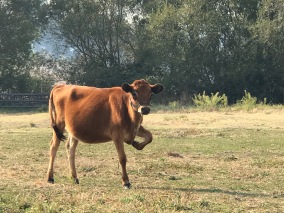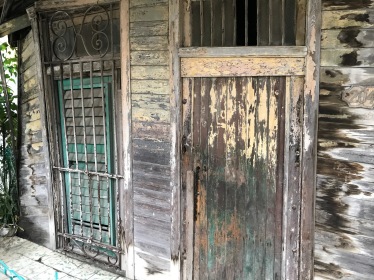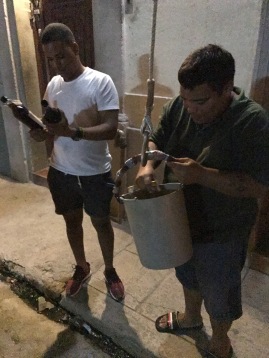The fastest NFL player can return a punt 100 yards – end zone to end zone – in about ten seconds. When the Northern California wild fires began raging uncontrollably throughout the wine country, it was traveling that same distance in just three.

One of nearly 10,000 structures burned
The fires started at night. Late at night and without warning. The Santa Ana winds nearing hurricane force strength. Flaming embers, some the size of softballs, traveled up to a mile through the night sky. Leaping across entire roadways…turning homes, cars, and buildings into piles of ash. A lifetime collection of memories becoming charred remains in seconds.
Two days after the fires began, we were on our way to San Francisco for a writing assignment with the World-Wide Opportunities on Organic Farms. WWOOF for short, is a hospitality service that organizes homestays on sustainable organic farms. Those who work on the land are called, WWOOFERS. And in exchange for their labor they get food, lodging and first-hand experience in organic growing methods. Founded nearly 50 years ago, the organization is now in more than 130 countries with over 2,000 farms spread across the United States.

Maple the Calf in the fields of Duckworth Farm
I scoured the WWOOF web site for a suitable farm, and settled on Duckworth. An 82-acre family-run farm outside Santa Rosa, in a tiny valley a few miles south of Sebastopol. They grow mostly blueberries, but also pears, apples, and plums. There are horses and sheep, cows and chickens, plenty of ducks and a few tractors. And we were excited to see it all.
Flying into San Francisco, on final approach around 10,000 feet, I noticed a faint fiery glow across the bay, just north of the city. We picked up the rental car and started towards our B&B in Santa Rosa, about an hour north of San Francisco, a few miles away from one of many evacuation lines. Driving over the Golden Gate Bridge I rolled up the windows to keep the smoke from filling the inside. We were still 60 miles from the flames.
In the morning, the sun, trying its best to peek through the smoke, spilled through the curtains and landed on my face. I thought I’d slept through my alarm, until I reached for my phone and realized I’d never set it. But I had slept through a few calls. Blinking my eyes awake, I hit “play” and listened to the first voice recording. It was Duckworth. All was fine at the farm. The fires were still several miles to the north…and we were invited to come by first thing Monday. So, we had three days. Three days to explore. Half a week to spend in a town that was on edge…and becoming edgier by the second.
Walking down for breakfast I took a seat against the parlor window and poured some orange juice into a thick bottomed glass. Across from me sat Judy and Felix, both retired doctors. They’d fled their condo and taken up residence in the room below me on the first night of the fire. I stood to introduce myself as Judy told me her story.
“We smelled smoke. Looked outside. Saw flames. And just got in the car.” She said. Never taking her eyes off her scrambled eggs. “We left so fast we had to leave Burt behind inside.” Hoping Burt was more than capable of driving himself to safety, I was somewhat relieved to find out Burt was a feral cat she’d been fostering.
At the head of the table was David, who worked in a fancy financial office. He explained his job, but I’m four years short of a Harvard degree. So, I just nodded as if it all made perfect sense.
For the next three days, our Breakfast Club started the day together. Sharing food, coffee and stories. Always trying to steer the conversation towards something more pleasant. But we always came back to Burt, the latest containment reports, and the people we’d been meeting as we traveled through Napa, Sonoma, and other neighboring towns.
One after another, we found people making a difference. People from all walks of life who gathered in parking lots and strip malls, forging for items their neighbors desperately needed. Neighbors, who’s names they didn’t even know.
From the famous – Guy Fieri cooking for firefighters – to the not-so well-known; a local restauranteur serving food, water, and apparel to nearly 2,000 people. We found the spirit of community everywhere.
Clara, a boutique clothing shop employee whose house burned to the ground, told us how her employer had moved her and her son into their home. And Foster, an artist who escaped the flames with his son, Max. Passing three people he didn’t know, who’d planted themselves in his front yard, digging trenches and scooping buckets of water from his neighbor’s pool to save his house. The very next day, Max cashed his entire paycheck and bought blankets, chargers, gift cards, waters, and batteries. Not for him and his dad, but for other evacuees.
There was an elderly man who grabbed a hose and kept the flames away from his neighbor’s house, while his home burned down behind him. A Santa Rosa man who turned his camper into a food shelter for first responders. Cooking meals and taking donations. We met a group of teenagers who volunteered at a pet shelter for misplaced animals. And two sisters who looked to be well into their 70’s, held hands and smiled, telling us they’d successfully alerted their neighbors before their condo caught flames.
When it came to the fires, six degrees of separation had been whittled to one. But not a single person we met, listened to, or learned of, ever spoke about their loss without mentioning their gains. How they’d each gained a newfound appreciation for being alive. And in the process, gained new friends who were now helping them overcome unimaginable loss.
Monday morning was the last call of our Breakfast Club. We were leaving the next day. Firefighters were getting the upper hand on a majority of the fires, and many of the mandatory evacuations were being lifted. Judy and Felix were heading back to their condo, where only minor smoke damage remained. Burt, was safe, too. A neighbor had spotted him through the window and alerted Judy an hour earlier.
David gobbled down his breakfast faster than usual. He was in a hurry to catch a flight for a business meeting in Palm Springs. Life was getting back to normal, it seemed. Whatever this new normal was going to look like.
As our club dissolved, we exchanged numbers and emails, shook hands and hugged one another…promising to keep in touch. It reminded me of my last day of High School. All of us rushing to sign each other’s yearbook before walking out of school one last time. Driving through the tiny town of Sebastopol, careening through its winding roads towards Duckworth Farm, I wondered if I’d hear from any of them again.
At the bottom of the valley, I turned into the farm and parked our dusty red rental alongside an old tractor. Trying to look cool in the rustic, rural setting. The tractor did. I looked…well, not.

Flowers in the Kitchen Garden at Duckworth Farm
Lorri, who runs the farm, and her daughter, Snazzy (who was about to run us all over the farm) greeted us in the driveway with a welcome reserved for long lost cousins who finally found their way back home. “Let’s go into the cookhouse.” Lorri said, leading the way. “We can talk in there.” Making my way into the building, sidestepping a handful of border collies, I felt that familiar sense of community we’d found in Sonoma, Napa, and elsewhere.
The cookhouse, a small 20X20 rectangular building, is the nucleus of the farm. A warm and inspiring feeling overwhelms you the moment you cross the threshold. Windows, from top to bottom, occupy the entire back wall. Looking out into the kitchen garden with its flowers and vegetables, the barn with its looms and cupolas, and the hills in the distance that form the valley.
Inside, in the left-hand corner, sat an antique stove with burners from a bygone era. Big clunky knobs stared up at a set of large pots and pans on top of the warmer oven. Dozens of cookbooks with worn out pages of recipes from pastries to pastas were stacked along the floor. And an ice cream maker lived just off to the right, opposite a large fully stacked freezer with enough food to feed an army. And it did. All the time. Dozens of glass jars, each with its contents half filled, lined up neatly along a wooden table in the middle of the room.
“We remove all the cooking items from their packaging, so our students can see the ingredients, as opposed to having processed foods in cans or boxes.” Lorri told us. “A box of product typically has one use. Ingredients are unlimited. So, I like them to see opportunities not products. That, and I really dislike advertisers in my kitchen.” She added.
The cookhouse is the place WOOFERS gather to make their meals. Succeeding or…not. But with little harm done, either way. “We’ve had spectacular success and horrific failures, and they both make great stories.” Lorri said. It’s also a place where one can feel truly safe. Free to talk about anything and everything. Confident their conversations will never pervade the four walls that surround them.
Lorri and her family eat off the farm the entire year. And the bread they share with others is never sliced. “There’s something about the ripping and tearing. It’s visceral. It’s…a moment. This is how we learn to trust each other.” Lorri told us. The food at Duckworth is their heritage, history, tradition, religion, and identity, all rolled into one. “If we don’t farm, harvest, prepare, cook and eat together, then we’ve lost a good part of what it means to be human in a community. When you share a meal with strangers, everyone becomes equal.”
And there are, of course, opportunities to learn and grow in the field, as well. While some WWOOFNG farms are more hands off, focusing only on agricultural technique, Duckworth teaches what vocational schooling leaves out; fixing engines and changing tires, welding, cooking, sewing and planting. If you’re not collecting eggs, you’re repairing fences. There’s sheering sheep (which I knew you could do) and milking them (which I didn’t). At Duckworth, if you’re not getting your hands dirty, you’re not living up to your full potential.
In the spring, there’s weeding and planting and prepping the blueberry fields. June is plum month. Blueberries are picked in July. Pear season starts in August and apples are readied in September. Winter months involve more weeding and more repairing.
Lather. Rinse. Repeat.
Lorri shared with us an email from a recent WWOOFER who had no experience in farm life until she spent a summer at Duckworth. “I am now fully prepared for any oncoming zombie apocalypse.” The post read.

Where the WWOOFERS live
The work here may be never ending. But it is never boring, and always rewarding. There are classes about plants and soil and taking care of animals. But WWOOFERS here also learn about taking care of each other. And as we wandered the property I realized we were walking the grounds of a communal boot camp for the important things in life.
At days end, we had played with – and learned about – cows, horses, goats and ducks. Snazzy taught us how to harvest, but not before we tried (unsuccessfully) to wrangle sheep. And gave up – perhaps a little too quickly – at getting anywhere close to catching a chicken. With nearly 100 acres there’s room for everyone. Animals and birds, bees and blueberries, WWOOFERS, and those seeking refuge from the wild fires. Duckworth Farm was accustomed to fighting with a fire for what they do. This time, they had to fight a fire that threatened who they serve.
At 2:00 am, the first morning of the fire, Lorri’s phone rang. It was a friend of hers, a local veterinarian:
“I said, “hello”, and she said, “Lorri, is your farm on fire?” I said, “No”, and she said, “I’m on my way, trailer behind me with the horses.” I told her I would have the barn ready and be outside waiting for her. We got her horses settled in the barn fairly quickly.”
Her family trailed behind her, bringing along their dog and two cats. Having lost everything – including their neighbor, who died in his home – they ended up staying on the farm for two weeks, until securing a rental property in nearby Petaluma. Also staying on the farm was a single mother from Coffee Park in Santa Rosa. Her and her 7-year-old daughter stayed in the barn until the evacuation order was lifted for their neighborhood.
Left in the fires’ wake was more than a billion dollars in damage. At least two dozen wineries destroyed. 200,000 acres scorched. Close to 10,000 homes and businesses gone. And over 40 people dead.
Too often, we conceive our world to be measured in square feet – the size of our homes. But when we realize that homesteads are actually measured in miles, new communities are formed. And community is the foundation of WWOOFING. The ground of its farms is sacred. Value is tied to it. It breathes life and breeds lasting bonds. On the flight home, we thought about the lessons we’d learned on the farm and in Northern California. How the dirt beneath us can be devastated, and we can still help change the world. They grow a lot of things on Duckworth Farm. But crops of compassion are what they raise best of all.















 We drove past dilapidated buildings with chipped paint, cracked windows, and exposed blocks of concrete set behind pro-revolutionary billboards of Fidel Castro coolly smoking cigars. Clothes, gently swaying in the warm, sticky breeze were pinned along clotheslines attached from one tin roof corner to the other.
We drove past dilapidated buildings with chipped paint, cracked windows, and exposed blocks of concrete set behind pro-revolutionary billboards of Fidel Castro coolly smoking cigars. Clothes, gently swaying in the warm, sticky breeze were pinned along clotheslines attached from one tin roof corner to the other.

 Winding through a narrow alley in a neighborhood where the streets truly had no name, our Chrysler careened its way around pedestrians. It wasn’t the derelict environment that stood out, in so much as it was the idleness of those living in it. Everyone seemed to be waiting for something to happen. Some squatted inside entryways where the doors had long since vanished, and others wandered the street aimlessly.
Winding through a narrow alley in a neighborhood where the streets truly had no name, our Chrysler careened its way around pedestrians. It wasn’t the derelict environment that stood out, in so much as it was the idleness of those living in it. Everyone seemed to be waiting for something to happen. Some squatted inside entryways where the doors had long since vanished, and others wandered the street aimlessly. The darkness did little to hide the fractured facades of the homes we drove past. And as our car came to rest in front of a nondescript door, I took notice of the dozen or so doorbells, each one connected with exposed wires that shot off in all directions. Careful not to touch anything, I traced my finger along the wires, trying to find the doorbell that matched the wine store.
The darkness did little to hide the fractured facades of the homes we drove past. And as our car came to rest in front of a nondescript door, I took notice of the dozen or so doorbells, each one connected with exposed wires that shot off in all directions. Careful not to touch anything, I traced my finger along the wires, trying to find the doorbell that matched the wine store.
 Field to Feast celebrates locally sourced ingredients with cuisine enjoyed in an open-air setting. The casual dine around
Field to Feast celebrates locally sourced ingredients with cuisine enjoyed in an open-air setting. The casual dine around  combines country charm with culinary excellence. New this year: Master Sommelier George Miliotes, who paired each dish with specially selected wines, beers, and cocktails. Guests enjoyed live music, farm tours, a raffle and more.
combines country charm with culinary excellence. New this year: Master Sommelier George Miliotes, who paired each dish with specially selected wines, beers, and cocktails. Guests enjoyed live music, farm tours, a raffle and more.




